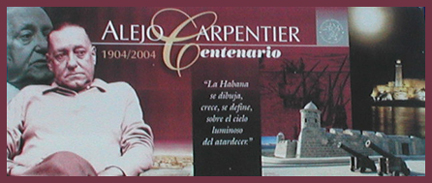Biography of Alejo Carpentier

Havana Billboard Celebrating the Birth Centenary of Alejo Carpentier
Credited by some as being the founder of "magic realism" and often
proposed as a recipient of a Nobel Prize for Literature, Alejo Carpentier was
passed over, possibly because of his support for the Cuban Revolution.
". . . bowed down by suffering and duties, beautiful in the midst of
his misery, capable of loving in the face of afflictions and trials, man
finds his greatness, his fullest measure, only in the Kingdom of This
World." (Alejo Carpentier, The Kingdom of This World, 185)
Alejo Carpentier, a pioneer in the use of the literary style of "magic realism," was born to a French father and a Russian mother in Lausanne, Switzerland on December 26th 1904. While he was a baby, his family moved to Havana; Cuba became Carpentier's adopted country. He received an excellent education in private schools and at the University of Havana before becoming involved in the Afro-Cuban movement which integrated African influences into Cuban music, dance and theatre.
Fleeing from the repression of Cuban dicator Gerardo Machado, Carpentier went to Paris where he published his first novel, Ecue-Yamba-O! (Praised Be God!) in 1933. From 1939 until 1945 he was back in Cuba, but susequently he moved to Caracas, Venezuela. In 1946 he published La música en Cuba (Music in Cuba). He then began publishing short stories using the technique that was to become known as ³magic realism.² In 1944 he published Viaje a la semilla, (Journey Back to the Source), a story set in 19th-century Cuba that is told in reverse order, ending with the protagonist's return to the womb. This was one of the stories included in the 1958 collection Guerra del tiempo ( War of Time). The Haitian revolution led by Henri Christophe against the French colonists in 1791 was the subject of Carpentier's second novel, El reino de este mundo (The Kingdom of This World); it is about the Haitian revolution. The 1953 novel Los pasos perdidos (The Lost Steps), is about a disenchanted composer's search of the meaning of life and the origins of time in the jungles of Orinoco.
After the triumph of the Cuban revolution in 1959, Carpentier returned to Havana. In 1962 he published a novel about the impact of the French Revolution in the Caribbean, El siglo de las luces (Explosion in a Cathedral). Although he lived and worked in Paris as a Cuban diplomat, his literary career continued with the publication of Concierto barroco and El recurso del metodo (Reasons of State) in 1974 followed by El arpa y la sombra (The Harp and the Shadow) and La consagracion de la primavera (The Consecration of Spring) in 1979. The latter two novels were about the life of Christopher Colombus and the Cuban Revolution.
Carpentier was struggling with cancer as he completed his final novel and he died in Paris on April 24, 1980.
Bibliography
Echevarria, Roberto Gonzalez. Alejo Carpentier: the pilgrim at home. Cornell University Press, 1977.
- - - - . "Alejo Carpentier." Encyclopaedia Britannica. 2004.
Pearl, Nancy and Andrea Kempf. "Viva Cuba: Contemporary Fiction." Library Journal. 1 April 2002, 168.
Return to the Literary Links Page
The background design features a detail from a 1971 Cuban postage stamp depicting
Diablito by Rene Portocarrero, a painting from the National Museum of Cuba.
© Grose Educational Media, 2004
|
